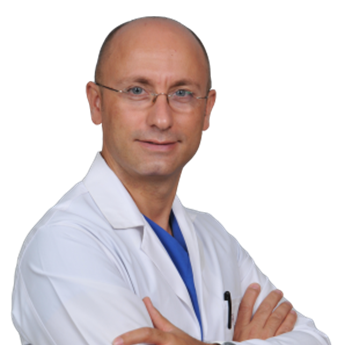ORTHOPEDICS AND TRAUMATOLOGY
_1691069667.png)
The Orthopaedics and Traumatology unit, which deals with musculoskeletal system diseases, is a very rich speciality in terms of diagnosis and treatment methods with many different sub-branches such as arms, legs, pelvic region, spine and bone, muscle, vascular, nerve and spinal cord connective tissues.
The Orthopaedics and Traumatology unit, which works in coordination with other units such as Physiotherapy and Rehabilitation, operates in a wide range of fields from hand surgery to prosthesis procedures.
The procedures performed in the Orthopaedics and Traumatology unit are as follows:
Hand Surgery - Microsurgery: The area from the fingertip to the shoulder area is included in the field of hand surgery. Problems such as bone fractures, tendon-muscle ruptures, nerve compression that occur in the area between the hand and the shoulder area are treated. Since hand surgery requires precise movements and coordination, it is an area that should be continued patiently. In addition, hand surgery includes the treatment of hand deformities caused by polydactyly (6 fingers), carpal tunnel syndrome (nerve compression), syndactyly (adhesion of fingers), CP sequelae. Thanks to the microsurgery technique, nerves smaller than 1 mm in diameter can be operated with the help of needles and threads that are very difficult to see even with the naked eye. In this way, organs such as severed arms, hands, legs and feet can be successfully replaced and very thin nerve fibres can be repaired.
Knee Surgery: The knee joint, which is exposed to the most load and strain compared to other joints, has a higher incidence of problems. In particular, not warming up enough before starting sports and overstraining the knees can cause damage to the cartilage tissue in this area, rupture of the ligaments or tear in the meniscus and disrupt knee health. Injuries of areas such as meniscus, articular cartilage, anterior cruciate ligament and capsule, septic arthritis (intra-articular inflammation), synovitis (thickening of the joint membrane), calcification of the knee joint and fractures occurring within the joint are treated with arthroscopic surgery.
Ankle Surgery: In the region called talus dome, diseases such as tibia distal end anterior compression, osteochondral damage, FHL tenosynovitis are treated. In the ankle operations performed with arthroscopy method, the inside of the joint is visually examined using fibreoptic instruments, and the diagnosis of diseases and injuries can be easily detected. A few small skin incisions are made with arthroscopy. This scar, which is very small in size, heals much faster than open surgery. The operation takes approximately 1 hour and the patient is discharged in a short time. A few days after the operation, you can step on your feet and even drive a car.
Shoulder Surgery: Problems such as SLAP lesion (biceps tendon damage), frozen shoulder, impingement, shoulder joint dislocation, tennis elbow and radius head dislocation are treated with closed or open surgical operations.
Paediatric Surgery: Congenital hip dislocation, Perthes disease, PEV sequelae, brachial plexus damage, walking disorders, torticollis, foot problems and spinal disorders are treated.
Oncological Surgery: Benign or malignant tumours developing in an area of the skeletal system such as muscle, bone, nerve, tendon and joint are treated.
Sports Traumatology: Sports, which increases the organic resistance of the body and improves the physiological capacities of the systems, is an occupation that brings injuries when started without proper preparations. The knee joint is one of the most common areas exposed to trauma in sports activities with a share of 33%. The other most common injuries are the thigh region of the foot, hip and groin region, shoulder joint, wrist and spine elbow joint. Emergency diagnosis and treatment of all sportive traumas are performed by specialised physicians.
Scoliosis Scoliosis is the curvature of the spine to the side or turning around itself. Scoliosis can occur due to many diseases. Scoliosis usually manifests itself during adolescence. It can also develop due to congenital anomalies of the spine or muscle and nerve diseases.
Kyphosis Kyphosis occurs when the hump, especially in the back, progresses excessively beyond normal values. Kyphosis can develop due to a person's posture disorder or spinal diseases.
Arthrosis-calcifications: Gonarthrosis and coxarthrosis treatment, hip-knee prostheses, revision surgeries in prosthesis infection and loosening, periacetabular and high tibial reconstructive bone surgeries are the areas of interest of this department.
Which Diseases Does Orthopaedics and Traumatology Treat?
Sports Injuries and Arthroscopic Surgery
Meniscectomy
Reconstruction operations,
Meniscus repair,
Microfracture and osteochondral cartilage transplantation,
Arthroscopic bankart repair (shoulder dislocation),
Labral tear repair,
Rotator sheath repair,
Shoulder osteoarthritis,
Foreign body removal.
Foot and Ankle Surgery
Cartilage injuries,
Ligament tears
Sports fractures and injuries,
Degenerative problems of the foot and ankle.
Elbow and Shoulder Surgery
Rotator sheath diseases,
Shoulder and elbow arthrosis,
Recurrent dislocations,
Trauma-related diseases such as falls, traffic accidents and work accidents.
Paediatric Orthopaedics and Traumatology
Clubfoot
Congenital disorders,
Flat sole
Hip dislocation
Tumours
Fracture treatment and follow-up.
Calcification (arthrosis)
Osteoarthritis of the knee (gonarthrosis),
Calcification of the hip (coxarthrosis),
Periacetabular and high tibial reconstructive bone operations,
Hip, knee, shoulder and elbow prosthesis,
Prosthesis infection,
Revision operations in prosthesis loosening
Hand Surgery, Extremity and Upper Extremity
Lengthening of arm and leg bones,
Bone deformities and infections,
Non-union of fractures,
Acute soft tissue trauma,
Repair of cut vessels and nerves,
Tendon transfers
Amputations




